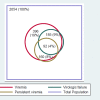HIV virologic failure and its predictors among HIV-infected adults on antiretroviral therapy in the African Cohort Study
- PMID: 30721233
- PMCID: PMC6363169
- DOI: 10.1371/journal.pone.0211344
HIV virologic failure and its predictors among HIV-infected adults on antiretroviral therapy in the African Cohort Study
Abstract
Introduction: The 2016 WHO consolidated guidelines on the use of antiretroviral drugs defines HIV virologic failure for low and middle income countries (LMIC) as plasma HIV-RNA ≥ 1000 copies/mL. We evaluated virologic failure and predictors in four African countries.
Materials and methods: We included HIV-infected participants on a WHO recommended antiretroviral therapy (ART) regimen and enrolled in the African Cohort Study between January 2013 and October 2017. Studied outcomes were virologic failure (plasma HIV-RNA ≥ 1000 copies/mL at the most recent visit), viraemia (plasma HIV-RNA ≥ 50 copies/mL at the most recent visit); and persistent viraemia (plasma HIV-RNA ≥ 50 copies/mL at two consecutive visits). Generalized linear models were used to estimate relative risks with their 95% confidence intervals.
Results: 2054 participants were included in this analysis. Viraemia, persistent viraemia and virologic failure were observed in 396 (19.3%), 160 (7.8%) and 184 (9%) participants respectively. Of the participants with persistent viraemia, only 57.5% (92/160) had confirmed virologic failure. In the multivariate analysis, attending clinical care site other than the Uganda sitebeing on 2nd line ART (aRR 1.8, 95% CI 1·28-2·66); other ART combinations not first line and not second line (aRR 3.8, 95% CI 1.18-11.9), a history of fever in the past week (aRR 3.7, 95% CI 1.69-8.05), low CD4 count (aRR 6.9, 95% CI 4.7-10.2) and missing any day of ART (aRR 1·8, 95% CI 1·27-2.57) increased the risk of virologic failure. Being on 2nd line therapy, the site where one receives care and CD4 count < 500 predicted viraemia, persistent viraemia and virologic failure.
Conclusion: In conclusion, these findings demonstrate that HIV-infected patients established on ART for more than six months in the African setting frequently experienced viraemia while continuing to be on ART. The findings also show that being on second line, low CD4 count, missing any day of ART and history of fever in the past week remain important predictors of virologic failure that should trigger intensified adherence counselling especially in the absence of reliable or readily available viral load monitoring. Finally, clinical care sites are different calling for further analyses to elucidate on the unique features of these sites.
Conflict of interest statement
Authors MM, MLR, JAA, CSP are affiliated with the U.S. Military HIV Research Program. The views expressed in this article are those of the authors and do not necessarily reflect the official policy or position of the U.S. Army or Department of Defense.
Figures
References
-
- UNAIDS, Joint United Nations Programme on HIV/AIDS: 90-90-90. An ambitious treatment target to help end the AIDS epidemic. Geneva, Switzerland, UNAIDS, Joint United Nations Programme on HIV/AIDS, 2014. October 40 p, 2014.
-
- WHO, 2016. Consolidated guidelines on the use of antiretroviral drugs for treating and preventing HIV infection Recommendations for a public health approach —Second edition World Health Organization, 2016. - PubMed
-
- UNAIDS, Ending AIDS: Progress towards the 90–90–90 targets. The Joint United Nations Programme on HIV/AID Global AIDS Update 2017. UNAIDS, 2017.
-
- UNAIDS, “15 BY 15” A GLOBAL TARGET. UNAIDS, Joint United Nations Programme on HIV/AIDS (UNAIDS), Geneva, Switzerland. UNAIDS, Joint United Nations Programme on HIV/AIDS (UNAIDS), Geneva, Switzerland. 2015.
Publication types
MeSH terms
Substances
Grants and funding
LinkOut - more resources
Full Text Sources
Medical
Research Materials
Miscellaneous




